Organizational Behavior Analysis at TMC
VerifiedAdded on 2020/01/07
|11
|3911
|176
Literature Review
AI Summary
This assignment delves into the organizational behavior of TMC (a fictional company). It examines their divisional structure, identifies suitable organizational theories for improvement, proposes leadership styles to boost employee morale, and analyzes the nature of formal and informal groups within TMC. The analysis emphasizes the importance of team building considering factors like group size, knowledge, skills, and abilities.
Contribute Materials
Your contribution can guide someone’s learning journey. Share your
documents today.
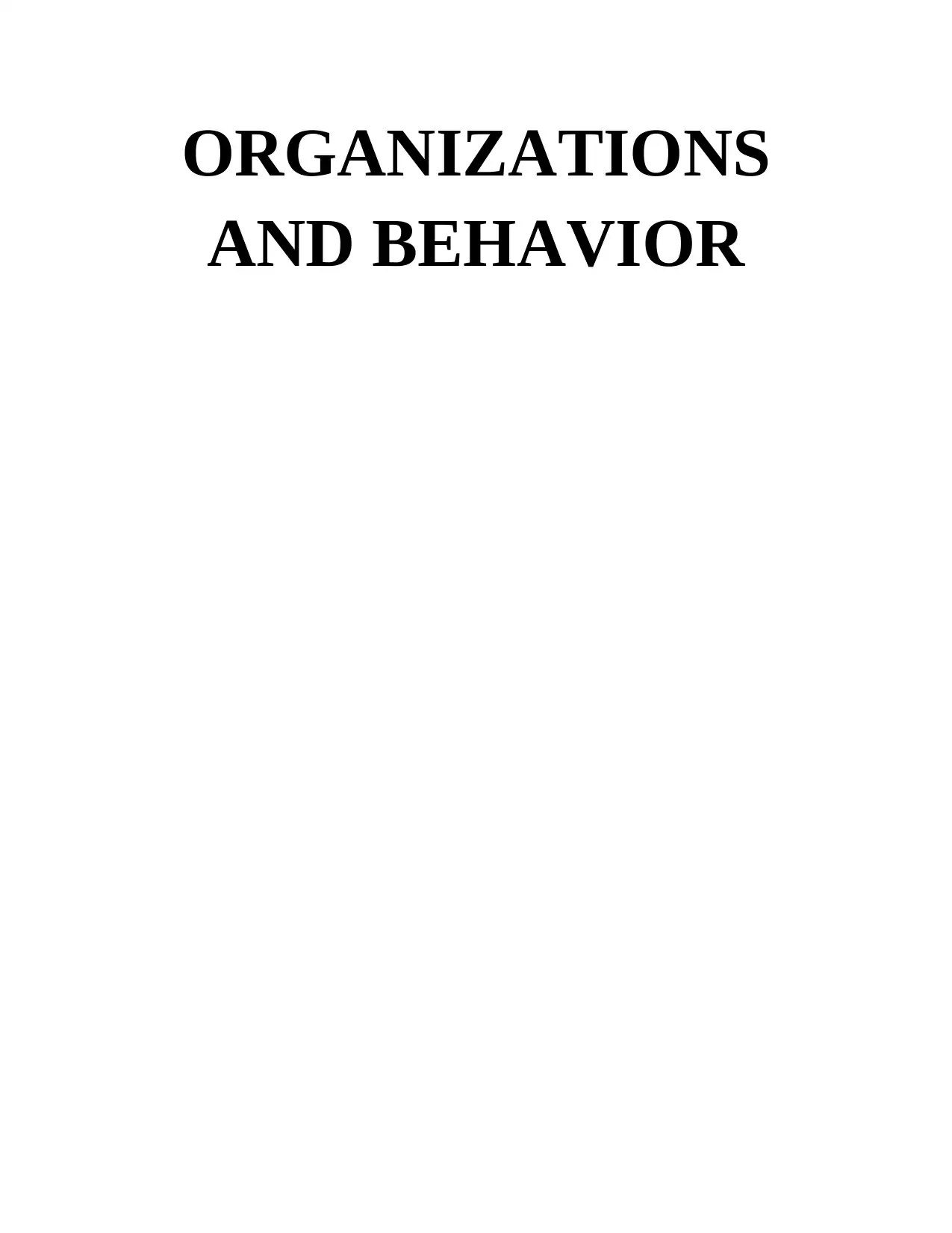
ORGANIZATIONS
AND BEHAVIOR
AND BEHAVIOR
Secure Best Marks with AI Grader
Need help grading? Try our AI Grader for instant feedback on your assignments.
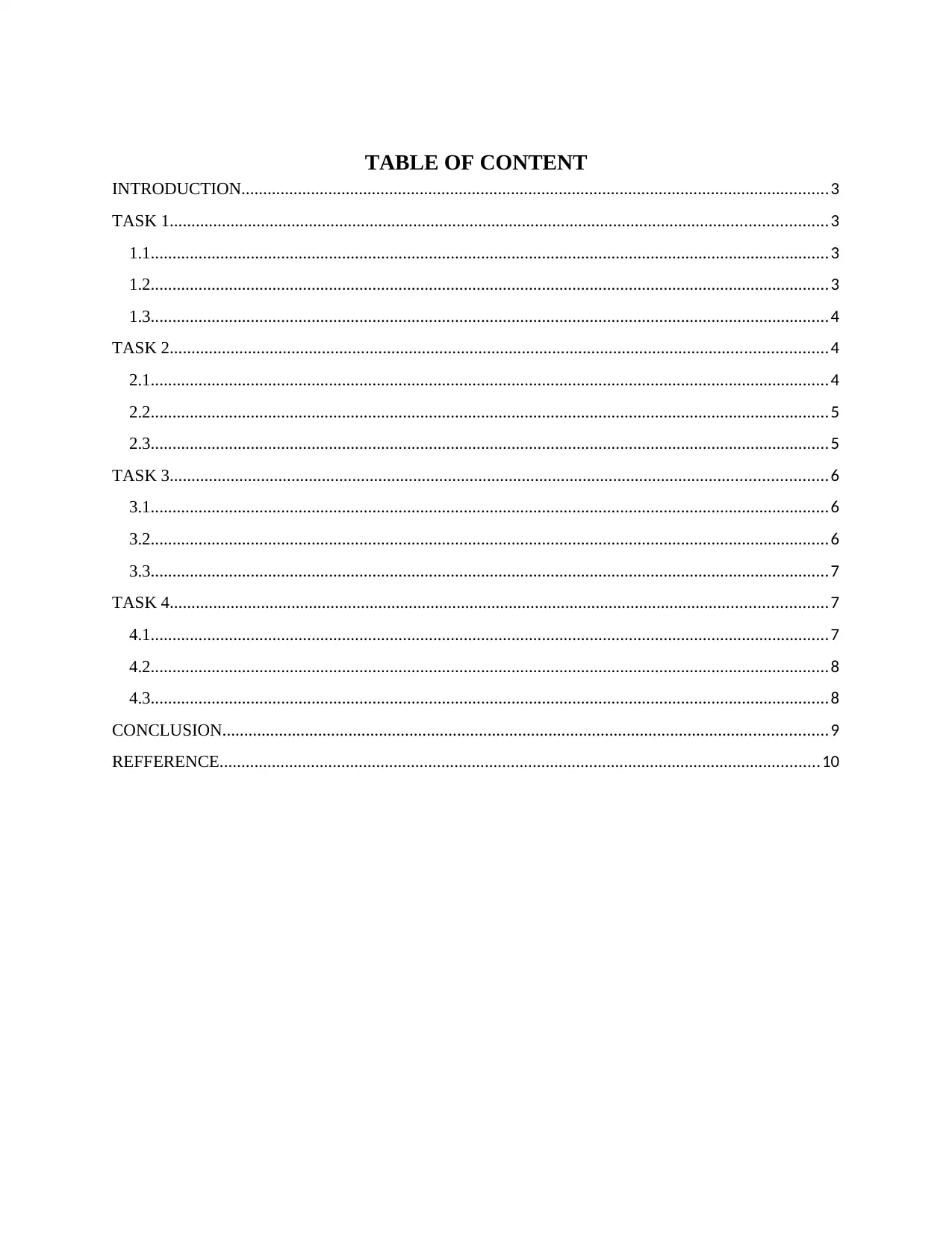
TABLE OF CONTENT
INTRODUCTION.......................................................................................................................................3
TASK 1.......................................................................................................................................................3
1.1............................................................................................................................................................3
1.2............................................................................................................................................................3
1.3............................................................................................................................................................4
TASK 2.......................................................................................................................................................4
2.1............................................................................................................................................................4
2.2............................................................................................................................................................5
2.3............................................................................................................................................................5
TASK 3.......................................................................................................................................................6
3.1............................................................................................................................................................6
3.2............................................................................................................................................................6
3.3............................................................................................................................................................7
TASK 4.......................................................................................................................................................7
4.1............................................................................................................................................................7
4.2............................................................................................................................................................8
4.3............................................................................................................................................................8
CONCLUSION...........................................................................................................................................9
REFFERENCE..........................................................................................................................................10
INTRODUCTION.......................................................................................................................................3
TASK 1.......................................................................................................................................................3
1.1............................................................................................................................................................3
1.2............................................................................................................................................................3
1.3............................................................................................................................................................4
TASK 2.......................................................................................................................................................4
2.1............................................................................................................................................................4
2.2............................................................................................................................................................5
2.3............................................................................................................................................................5
TASK 3.......................................................................................................................................................6
3.1............................................................................................................................................................6
3.2............................................................................................................................................................6
3.3............................................................................................................................................................7
TASK 4.......................................................................................................................................................7
4.1............................................................................................................................................................7
4.2............................................................................................................................................................8
4.3............................................................................................................................................................8
CONCLUSION...........................................................................................................................................9
REFFERENCE..........................................................................................................................................10
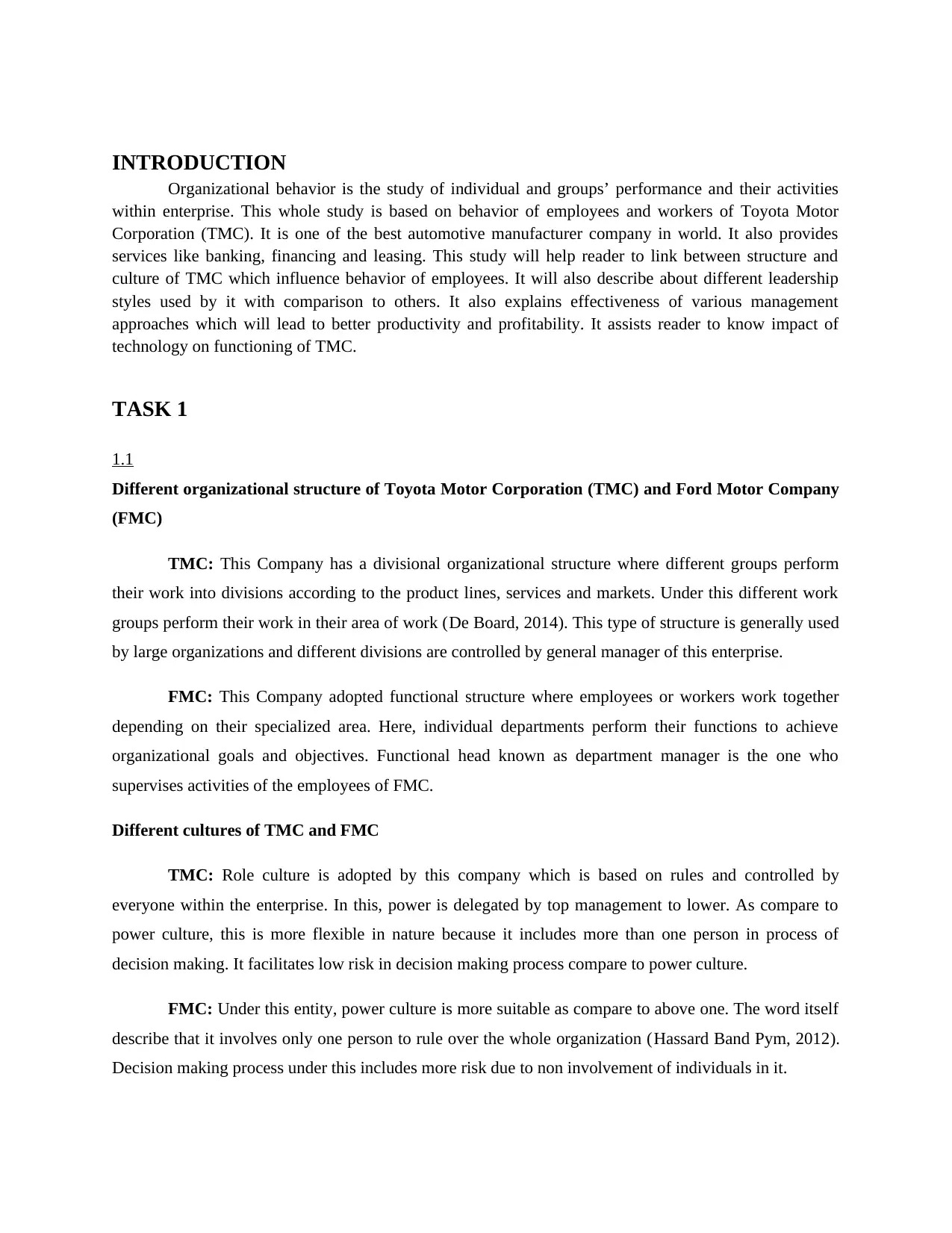
INTRODUCTION
Organizational behavior is the study of individual and groups’ performance and their activities
within enterprise. This whole study is based on behavior of employees and workers of Toyota Motor
Corporation (TMC). It is one of the best automotive manufacturer company in world. It also provides
services like banking, financing and leasing. This study will help reader to link between structure and
culture of TMC which influence behavior of employees. It will also describe about different leadership
styles used by it with comparison to others. It also explains effectiveness of various management
approaches which will lead to better productivity and profitability. It assists reader to know impact of
technology on functioning of TMC.
TASK 1
1.1
Different organizational structure of Toyota Motor Corporation (TMC) and Ford Motor Company
(FMC)
TMC: This Company has a divisional organizational structure where different groups perform
their work into divisions according to the product lines, services and markets. Under this different work
groups perform their work in their area of work (De Board, 2014). This type of structure is generally used
by large organizations and different divisions are controlled by general manager of this enterprise.
FMC: This Company adopted functional structure where employees or workers work together
depending on their specialized area. Here, individual departments perform their functions to achieve
organizational goals and objectives. Functional head known as department manager is the one who
supervises activities of the employees of FMC.
Different cultures of TMC and FMC
TMC: Role culture is adopted by this company which is based on rules and controlled by
everyone within the enterprise. In this, power is delegated by top management to lower. As compare to
power culture, this is more flexible in nature because it includes more than one person in process of
decision making. It facilitates low risk in decision making process compare to power culture.
FMC: Under this entity, power culture is more suitable as compare to above one. The word itself
describe that it involves only one person to rule over the whole organization (Hassard Band Pym, 2012).
Decision making process under this includes more risk due to non involvement of individuals in it.
Organizational behavior is the study of individual and groups’ performance and their activities
within enterprise. This whole study is based on behavior of employees and workers of Toyota Motor
Corporation (TMC). It is one of the best automotive manufacturer company in world. It also provides
services like banking, financing and leasing. This study will help reader to link between structure and
culture of TMC which influence behavior of employees. It will also describe about different leadership
styles used by it with comparison to others. It also explains effectiveness of various management
approaches which will lead to better productivity and profitability. It assists reader to know impact of
technology on functioning of TMC.
TASK 1
1.1
Different organizational structure of Toyota Motor Corporation (TMC) and Ford Motor Company
(FMC)
TMC: This Company has a divisional organizational structure where different groups perform
their work into divisions according to the product lines, services and markets. Under this different work
groups perform their work in their area of work (De Board, 2014). This type of structure is generally used
by large organizations and different divisions are controlled by general manager of this enterprise.
FMC: This Company adopted functional structure where employees or workers work together
depending on their specialized area. Here, individual departments perform their functions to achieve
organizational goals and objectives. Functional head known as department manager is the one who
supervises activities of the employees of FMC.
Different cultures of TMC and FMC
TMC: Role culture is adopted by this company which is based on rules and controlled by
everyone within the enterprise. In this, power is delegated by top management to lower. As compare to
power culture, this is more flexible in nature because it includes more than one person in process of
decision making. It facilitates low risk in decision making process compare to power culture.
FMC: Under this entity, power culture is more suitable as compare to above one. The word itself
describe that it involves only one person to rule over the whole organization (Hassard Band Pym, 2012).
Decision making process under this includes more risk due to non involvement of individuals in it.
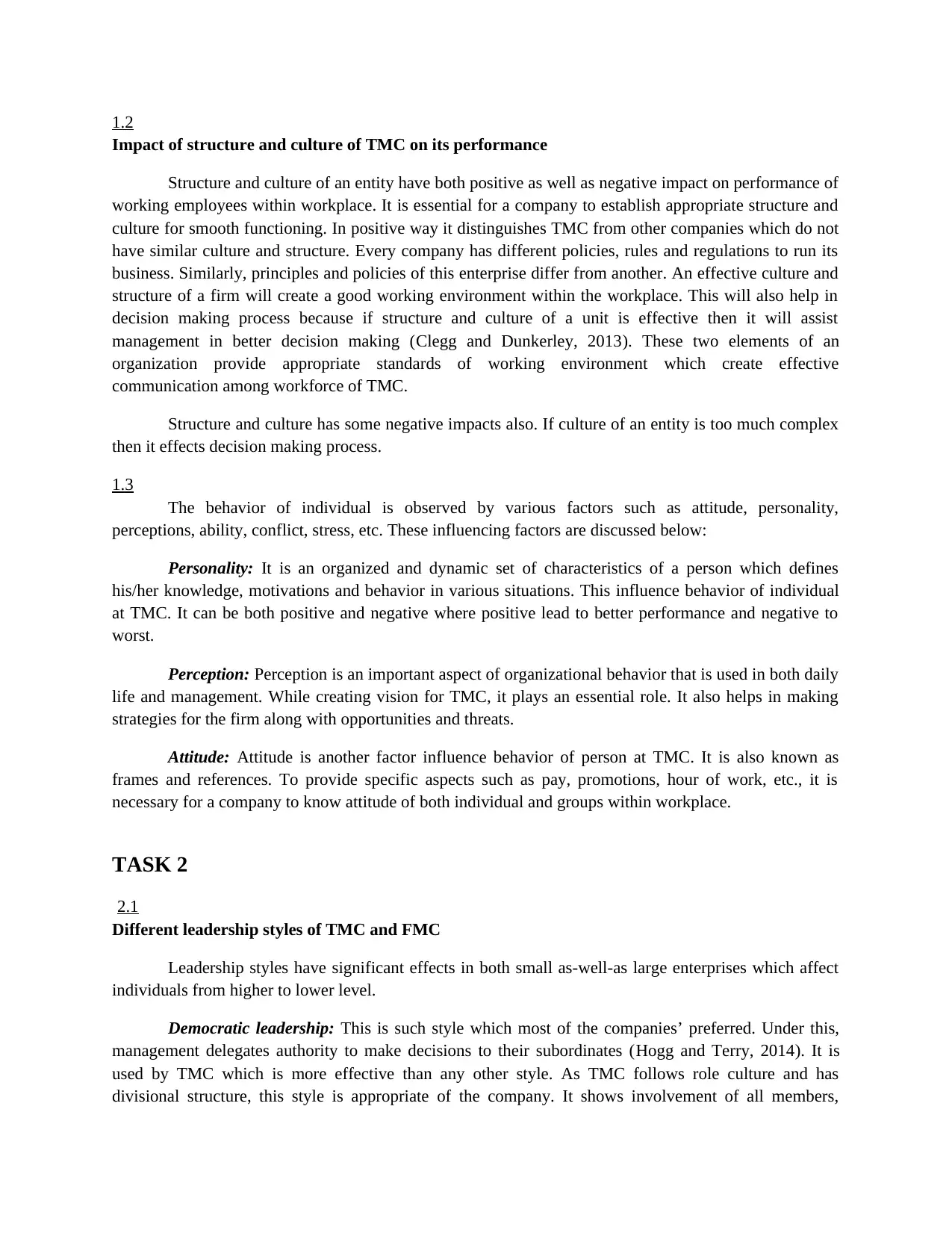
1.2
Impact of structure and culture of TMC on its performance
Structure and culture of an entity have both positive as well as negative impact on performance of
working employees within workplace. It is essential for a company to establish appropriate structure and
culture for smooth functioning. In positive way it distinguishes TMC from other companies which do not
have similar culture and structure. Every company has different policies, rules and regulations to run its
business. Similarly, principles and policies of this enterprise differ from another. An effective culture and
structure of a firm will create a good working environment within the workplace. This will also help in
decision making process because if structure and culture of a unit is effective then it will assist
management in better decision making (Clegg and Dunkerley, 2013). These two elements of an
organization provide appropriate standards of working environment which create effective
communication among workforce of TMC.
Structure and culture has some negative impacts also. If culture of an entity is too much complex
then it effects decision making process.
1.3
The behavior of individual is observed by various factors such as attitude, personality,
perceptions, ability, conflict, stress, etc. These influencing factors are discussed below:
Personality: It is an organized and dynamic set of characteristics of a person which defines
his/her knowledge, motivations and behavior in various situations. This influence behavior of individual
at TMC. It can be both positive and negative where positive lead to better performance and negative to
worst.
Perception: Perception is an important aspect of organizational behavior that is used in both daily
life and management. While creating vision for TMC, it plays an essential role. It also helps in making
strategies for the firm along with opportunities and threats.
Attitude: Attitude is another factor influence behavior of person at TMC. It is also known as
frames and references. To provide specific aspects such as pay, promotions, hour of work, etc., it is
necessary for a company to know attitude of both individual and groups within workplace.
TASK 2
2.1
Different leadership styles of TMC and FMC
Leadership styles have significant effects in both small as-well-as large enterprises which affect
individuals from higher to lower level.
Democratic leadership: This is such style which most of the companies’ preferred. Under this,
management delegates authority to make decisions to their subordinates (Hogg and Terry, 2014). It is
used by TMC which is more effective than any other style. As TMC follows role culture and has
divisional structure, this style is appropriate of the company. It shows involvement of all members,
Impact of structure and culture of TMC on its performance
Structure and culture of an entity have both positive as well as negative impact on performance of
working employees within workplace. It is essential for a company to establish appropriate structure and
culture for smooth functioning. In positive way it distinguishes TMC from other companies which do not
have similar culture and structure. Every company has different policies, rules and regulations to run its
business. Similarly, principles and policies of this enterprise differ from another. An effective culture and
structure of a firm will create a good working environment within the workplace. This will also help in
decision making process because if structure and culture of a unit is effective then it will assist
management in better decision making (Clegg and Dunkerley, 2013). These two elements of an
organization provide appropriate standards of working environment which create effective
communication among workforce of TMC.
Structure and culture has some negative impacts also. If culture of an entity is too much complex
then it effects decision making process.
1.3
The behavior of individual is observed by various factors such as attitude, personality,
perceptions, ability, conflict, stress, etc. These influencing factors are discussed below:
Personality: It is an organized and dynamic set of characteristics of a person which defines
his/her knowledge, motivations and behavior in various situations. This influence behavior of individual
at TMC. It can be both positive and negative where positive lead to better performance and negative to
worst.
Perception: Perception is an important aspect of organizational behavior that is used in both daily
life and management. While creating vision for TMC, it plays an essential role. It also helps in making
strategies for the firm along with opportunities and threats.
Attitude: Attitude is another factor influence behavior of person at TMC. It is also known as
frames and references. To provide specific aspects such as pay, promotions, hour of work, etc., it is
necessary for a company to know attitude of both individual and groups within workplace.
TASK 2
2.1
Different leadership styles of TMC and FMC
Leadership styles have significant effects in both small as-well-as large enterprises which affect
individuals from higher to lower level.
Democratic leadership: This is such style which most of the companies’ preferred. Under this,
management delegates authority to make decisions to their subordinates (Hogg and Terry, 2014). It is
used by TMC which is more effective than any other style. As TMC follows role culture and has
divisional structure, this style is appropriate of the company. It shows involvement of all members,
Secure Best Marks with AI Grader
Need help grading? Try our AI Grader for instant feedback on your assignments.
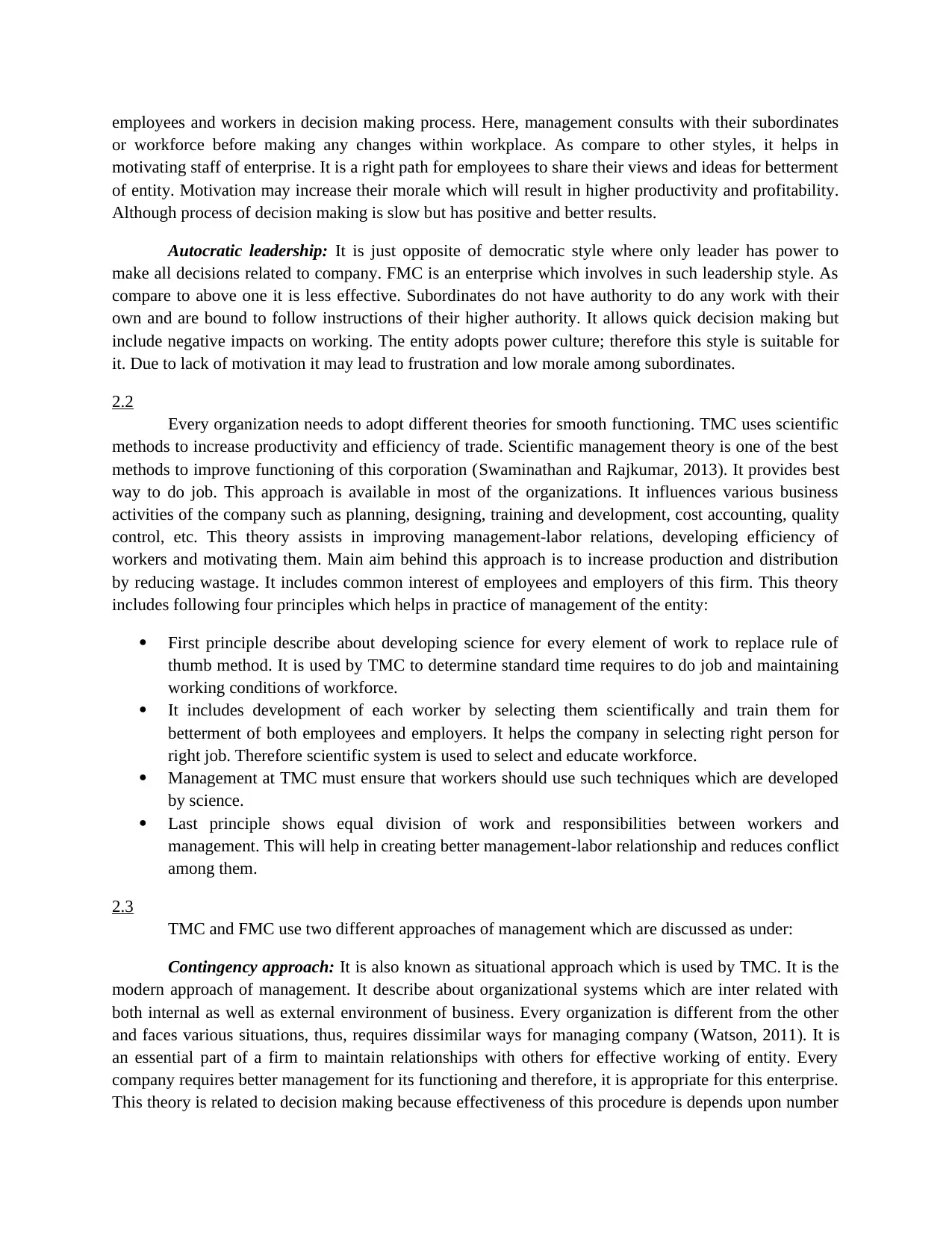
employees and workers in decision making process. Here, management consults with their subordinates
or workforce before making any changes within workplace. As compare to other styles, it helps in
motivating staff of enterprise. It is a right path for employees to share their views and ideas for betterment
of entity. Motivation may increase their morale which will result in higher productivity and profitability.
Although process of decision making is slow but has positive and better results.
Autocratic leadership: It is just opposite of democratic style where only leader has power to
make all decisions related to company. FMC is an enterprise which involves in such leadership style. As
compare to above one it is less effective. Subordinates do not have authority to do any work with their
own and are bound to follow instructions of their higher authority. It allows quick decision making but
include negative impacts on working. The entity adopts power culture; therefore this style is suitable for
it. Due to lack of motivation it may lead to frustration and low morale among subordinates.
2.2
Every organization needs to adopt different theories for smooth functioning. TMC uses scientific
methods to increase productivity and efficiency of trade. Scientific management theory is one of the best
methods to improve functioning of this corporation (Swaminathan and Rajkumar, 2013). It provides best
way to do job. This approach is available in most of the organizations. It influences various business
activities of the company such as planning, designing, training and development, cost accounting, quality
control, etc. This theory assists in improving management-labor relations, developing efficiency of
workers and motivating them. Main aim behind this approach is to increase production and distribution
by reducing wastage. It includes common interest of employees and employers of this firm. This theory
includes following four principles which helps in practice of management of the entity:
First principle describe about developing science for every element of work to replace rule of
thumb method. It is used by TMC to determine standard time requires to do job and maintaining
working conditions of workforce.
It includes development of each worker by selecting them scientifically and train them for
betterment of both employees and employers. It helps the company in selecting right person for
right job. Therefore scientific system is used to select and educate workforce.
Management at TMC must ensure that workers should use such techniques which are developed
by science.
Last principle shows equal division of work and responsibilities between workers and
management. This will help in creating better management-labor relationship and reduces conflict
among them.
2.3
TMC and FMC use two different approaches of management which are discussed as under:
Contingency approach: It is also known as situational approach which is used by TMC. It is the
modern approach of management. It describe about organizational systems which are inter related with
both internal as well as external environment of business. Every organization is different from the other
and faces various situations, thus, requires dissimilar ways for managing company (Watson, 2011). It is
an essential part of a firm to maintain relationships with others for effective working of entity. Every
company requires better management for its functioning and therefore, it is appropriate for this enterprise.
This theory is related to decision making because effectiveness of this procedure is depends upon number
or workforce before making any changes within workplace. As compare to other styles, it helps in
motivating staff of enterprise. It is a right path for employees to share their views and ideas for betterment
of entity. Motivation may increase their morale which will result in higher productivity and profitability.
Although process of decision making is slow but has positive and better results.
Autocratic leadership: It is just opposite of democratic style where only leader has power to
make all decisions related to company. FMC is an enterprise which involves in such leadership style. As
compare to above one it is less effective. Subordinates do not have authority to do any work with their
own and are bound to follow instructions of their higher authority. It allows quick decision making but
include negative impacts on working. The entity adopts power culture; therefore this style is suitable for
it. Due to lack of motivation it may lead to frustration and low morale among subordinates.
2.2
Every organization needs to adopt different theories for smooth functioning. TMC uses scientific
methods to increase productivity and efficiency of trade. Scientific management theory is one of the best
methods to improve functioning of this corporation (Swaminathan and Rajkumar, 2013). It provides best
way to do job. This approach is available in most of the organizations. It influences various business
activities of the company such as planning, designing, training and development, cost accounting, quality
control, etc. This theory assists in improving management-labor relations, developing efficiency of
workers and motivating them. Main aim behind this approach is to increase production and distribution
by reducing wastage. It includes common interest of employees and employers of this firm. This theory
includes following four principles which helps in practice of management of the entity:
First principle describe about developing science for every element of work to replace rule of
thumb method. It is used by TMC to determine standard time requires to do job and maintaining
working conditions of workforce.
It includes development of each worker by selecting them scientifically and train them for
betterment of both employees and employers. It helps the company in selecting right person for
right job. Therefore scientific system is used to select and educate workforce.
Management at TMC must ensure that workers should use such techniques which are developed
by science.
Last principle shows equal division of work and responsibilities between workers and
management. This will help in creating better management-labor relationship and reduces conflict
among them.
2.3
TMC and FMC use two different approaches of management which are discussed as under:
Contingency approach: It is also known as situational approach which is used by TMC. It is the
modern approach of management. It describe about organizational systems which are inter related with
both internal as well as external environment of business. Every organization is different from the other
and faces various situations, thus, requires dissimilar ways for managing company (Watson, 2011). It is
an essential part of a firm to maintain relationships with others for effective working of entity. Every
company requires better management for its functioning and therefore, it is appropriate for this enterprise.
This theory is related to decision making because effectiveness of this procedure is depends upon number
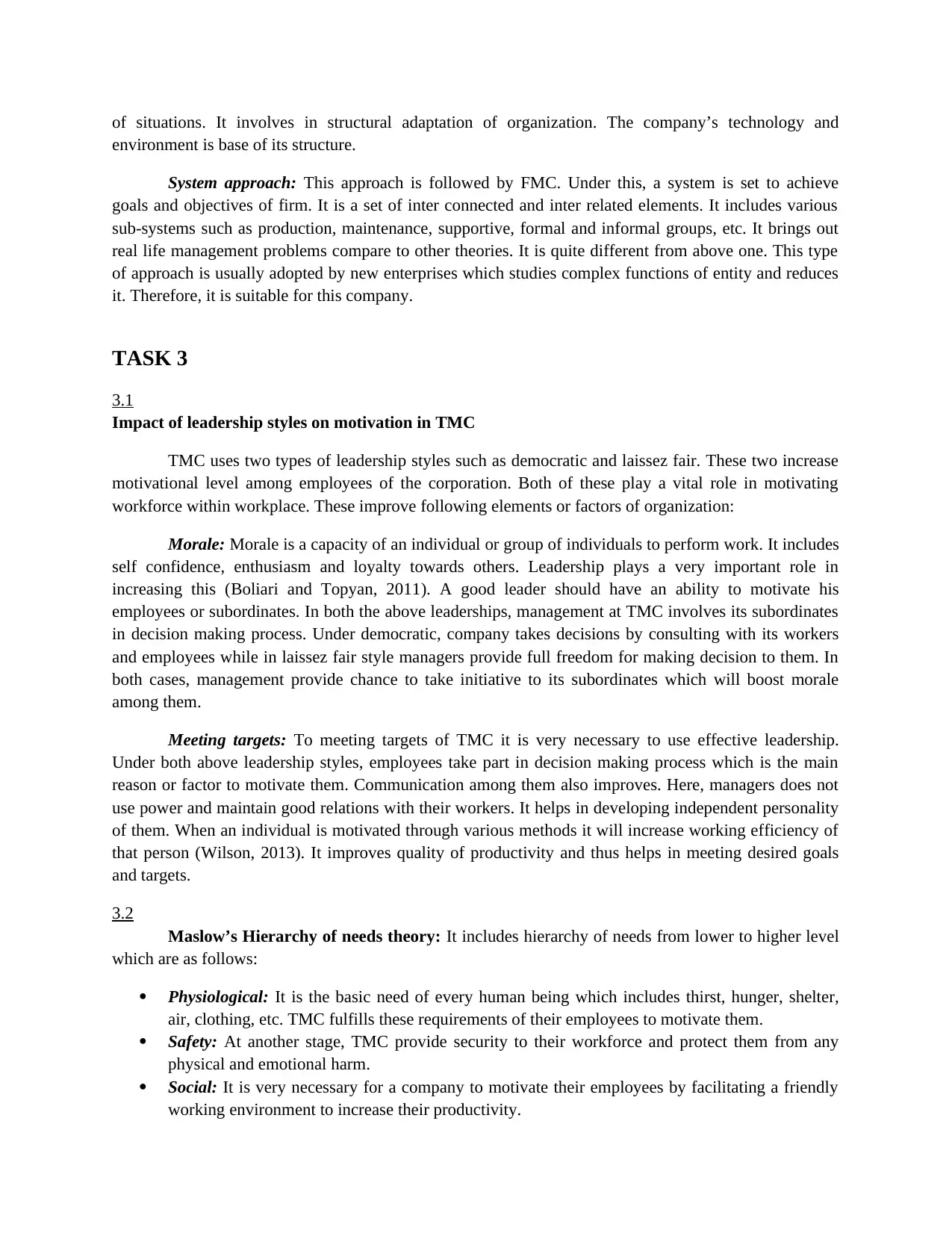
of situations. It involves in structural adaptation of organization. The company’s technology and
environment is base of its structure.
System approach: This approach is followed by FMC. Under this, a system is set to achieve
goals and objectives of firm. It is a set of inter connected and inter related elements. It includes various
sub-systems such as production, maintenance, supportive, formal and informal groups, etc. It brings out
real life management problems compare to other theories. It is quite different from above one. This type
of approach is usually adopted by new enterprises which studies complex functions of entity and reduces
it. Therefore, it is suitable for this company.
TASK 3
3.1
Impact of leadership styles on motivation in TMC
TMC uses two types of leadership styles such as democratic and laissez fair. These two increase
motivational level among employees of the corporation. Both of these play a vital role in motivating
workforce within workplace. These improve following elements or factors of organization:
Morale: Morale is a capacity of an individual or group of individuals to perform work. It includes
self confidence, enthusiasm and loyalty towards others. Leadership plays a very important role in
increasing this (Boliari and Topyan, 2011). A good leader should have an ability to motivate his
employees or subordinates. In both the above leaderships, management at TMC involves its subordinates
in decision making process. Under democratic, company takes decisions by consulting with its workers
and employees while in laissez fair style managers provide full freedom for making decision to them. In
both cases, management provide chance to take initiative to its subordinates which will boost morale
among them.
Meeting targets: To meeting targets of TMC it is very necessary to use effective leadership.
Under both above leadership styles, employees take part in decision making process which is the main
reason or factor to motivate them. Communication among them also improves. Here, managers does not
use power and maintain good relations with their workers. It helps in developing independent personality
of them. When an individual is motivated through various methods it will increase working efficiency of
that person (Wilson, 2013). It improves quality of productivity and thus helps in meeting desired goals
and targets.
3.2
Maslow’s Hierarchy of needs theory: It includes hierarchy of needs from lower to higher level
which are as follows:
Physiological: It is the basic need of every human being which includes thirst, hunger, shelter,
air, clothing, etc. TMC fulfills these requirements of their employees to motivate them.
Safety: At another stage, TMC provide security to their workforce and protect them from any
physical and emotional harm.
Social: It is very necessary for a company to motivate their employees by facilitating a friendly
working environment to increase their productivity.
environment is base of its structure.
System approach: This approach is followed by FMC. Under this, a system is set to achieve
goals and objectives of firm. It is a set of inter connected and inter related elements. It includes various
sub-systems such as production, maintenance, supportive, formal and informal groups, etc. It brings out
real life management problems compare to other theories. It is quite different from above one. This type
of approach is usually adopted by new enterprises which studies complex functions of entity and reduces
it. Therefore, it is suitable for this company.
TASK 3
3.1
Impact of leadership styles on motivation in TMC
TMC uses two types of leadership styles such as democratic and laissez fair. These two increase
motivational level among employees of the corporation. Both of these play a vital role in motivating
workforce within workplace. These improve following elements or factors of organization:
Morale: Morale is a capacity of an individual or group of individuals to perform work. It includes
self confidence, enthusiasm and loyalty towards others. Leadership plays a very important role in
increasing this (Boliari and Topyan, 2011). A good leader should have an ability to motivate his
employees or subordinates. In both the above leaderships, management at TMC involves its subordinates
in decision making process. Under democratic, company takes decisions by consulting with its workers
and employees while in laissez fair style managers provide full freedom for making decision to them. In
both cases, management provide chance to take initiative to its subordinates which will boost morale
among them.
Meeting targets: To meeting targets of TMC it is very necessary to use effective leadership.
Under both above leadership styles, employees take part in decision making process which is the main
reason or factor to motivate them. Communication among them also improves. Here, managers does not
use power and maintain good relations with their workers. It helps in developing independent personality
of them. When an individual is motivated through various methods it will increase working efficiency of
that person (Wilson, 2013). It improves quality of productivity and thus helps in meeting desired goals
and targets.
3.2
Maslow’s Hierarchy of needs theory: It includes hierarchy of needs from lower to higher level
which are as follows:
Physiological: It is the basic need of every human being which includes thirst, hunger, shelter,
air, clothing, etc. TMC fulfills these requirements of their employees to motivate them.
Safety: At another stage, TMC provide security to their workforce and protect them from any
physical and emotional harm.
Social: It is very necessary for a company to motivate their employees by facilitating a friendly
working environment to increase their productivity.
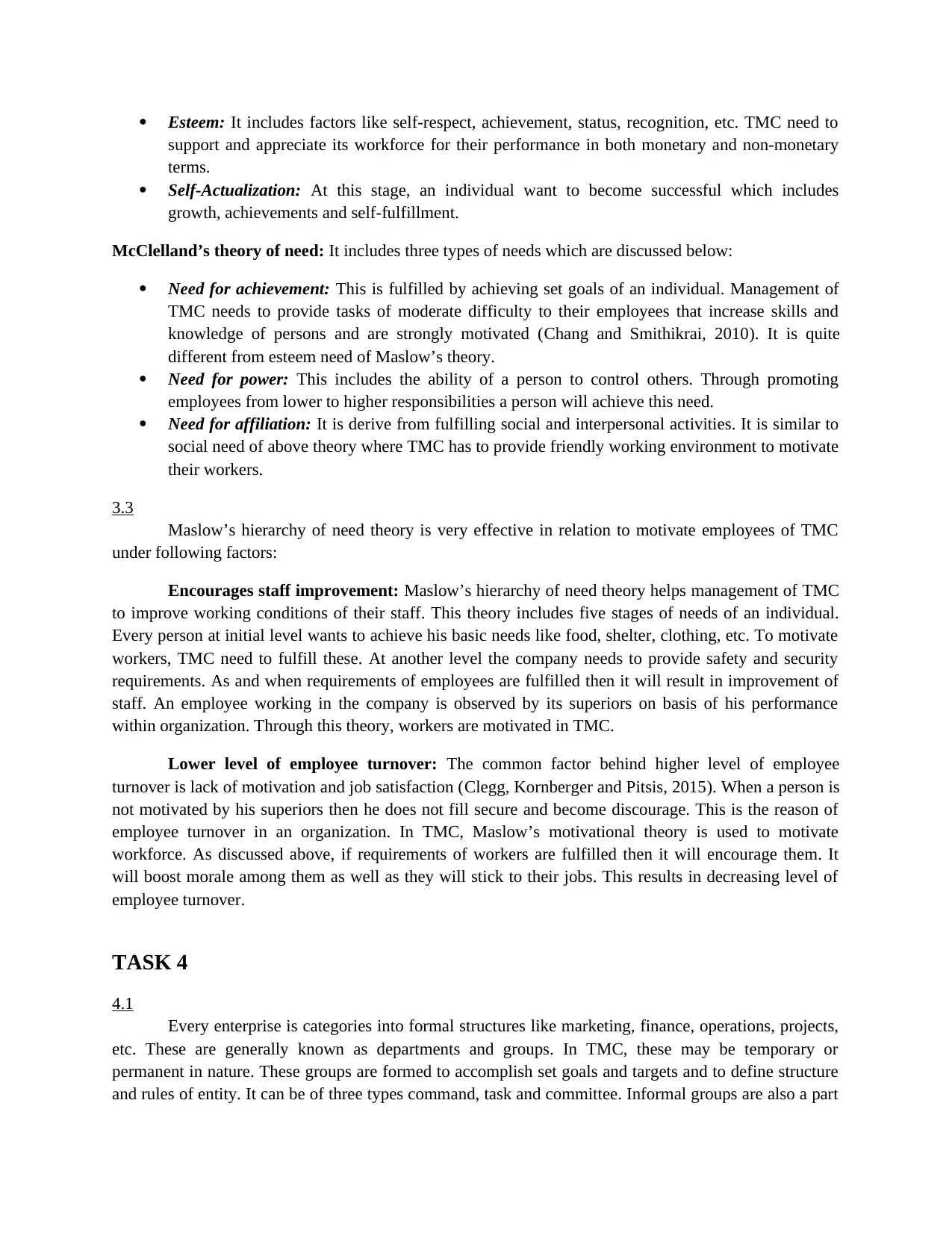
Esteem: It includes factors like self-respect, achievement, status, recognition, etc. TMC need to
support and appreciate its workforce for their performance in both monetary and non-monetary
terms.
Self-Actualization: At this stage, an individual want to become successful which includes
growth, achievements and self-fulfillment.
McClelland’s theory of need: It includes three types of needs which are discussed below:
Need for achievement: This is fulfilled by achieving set goals of an individual. Management of
TMC needs to provide tasks of moderate difficulty to their employees that increase skills and
knowledge of persons and are strongly motivated (Chang and Smithikrai, 2010). It is quite
different from esteem need of Maslow’s theory.
Need for power: This includes the ability of a person to control others. Through promoting
employees from lower to higher responsibilities a person will achieve this need.
Need for affiliation: It is derive from fulfilling social and interpersonal activities. It is similar to
social need of above theory where TMC has to provide friendly working environment to motivate
their workers.
3.3
Maslow’s hierarchy of need theory is very effective in relation to motivate employees of TMC
under following factors:
Encourages staff improvement: Maslow’s hierarchy of need theory helps management of TMC
to improve working conditions of their staff. This theory includes five stages of needs of an individual.
Every person at initial level wants to achieve his basic needs like food, shelter, clothing, etc. To motivate
workers, TMC need to fulfill these. At another level the company needs to provide safety and security
requirements. As and when requirements of employees are fulfilled then it will result in improvement of
staff. An employee working in the company is observed by its superiors on basis of his performance
within organization. Through this theory, workers are motivated in TMC.
Lower level of employee turnover: The common factor behind higher level of employee
turnover is lack of motivation and job satisfaction (Clegg, Kornberger and Pitsis, 2015). When a person is
not motivated by his superiors then he does not fill secure and become discourage. This is the reason of
employee turnover in an organization. In TMC, Maslow’s motivational theory is used to motivate
workforce. As discussed above, if requirements of workers are fulfilled then it will encourage them. It
will boost morale among them as well as they will stick to their jobs. This results in decreasing level of
employee turnover.
TASK 4
4.1
Every enterprise is categories into formal structures like marketing, finance, operations, projects,
etc. These are generally known as departments and groups. In TMC, these may be temporary or
permanent in nature. These groups are formed to accomplish set goals and targets and to define structure
and rules of entity. It can be of three types command, task and committee. Informal groups are also a part
support and appreciate its workforce for their performance in both monetary and non-monetary
terms.
Self-Actualization: At this stage, an individual want to become successful which includes
growth, achievements and self-fulfillment.
McClelland’s theory of need: It includes three types of needs which are discussed below:
Need for achievement: This is fulfilled by achieving set goals of an individual. Management of
TMC needs to provide tasks of moderate difficulty to their employees that increase skills and
knowledge of persons and are strongly motivated (Chang and Smithikrai, 2010). It is quite
different from esteem need of Maslow’s theory.
Need for power: This includes the ability of a person to control others. Through promoting
employees from lower to higher responsibilities a person will achieve this need.
Need for affiliation: It is derive from fulfilling social and interpersonal activities. It is similar to
social need of above theory where TMC has to provide friendly working environment to motivate
their workers.
3.3
Maslow’s hierarchy of need theory is very effective in relation to motivate employees of TMC
under following factors:
Encourages staff improvement: Maslow’s hierarchy of need theory helps management of TMC
to improve working conditions of their staff. This theory includes five stages of needs of an individual.
Every person at initial level wants to achieve his basic needs like food, shelter, clothing, etc. To motivate
workers, TMC need to fulfill these. At another level the company needs to provide safety and security
requirements. As and when requirements of employees are fulfilled then it will result in improvement of
staff. An employee working in the company is observed by its superiors on basis of his performance
within organization. Through this theory, workers are motivated in TMC.
Lower level of employee turnover: The common factor behind higher level of employee
turnover is lack of motivation and job satisfaction (Clegg, Kornberger and Pitsis, 2015). When a person is
not motivated by his superiors then he does not fill secure and become discourage. This is the reason of
employee turnover in an organization. In TMC, Maslow’s motivational theory is used to motivate
workforce. As discussed above, if requirements of workers are fulfilled then it will encourage them. It
will boost morale among them as well as they will stick to their jobs. This results in decreasing level of
employee turnover.
TASK 4
4.1
Every enterprise is categories into formal structures like marketing, finance, operations, projects,
etc. These are generally known as departments and groups. In TMC, these may be temporary or
permanent in nature. These groups are formed to accomplish set goals and targets and to define structure
and rules of entity. It can be of three types command, task and committee. Informal groups are also a part
Paraphrase This Document
Need a fresh take? Get an instant paraphrase of this document with our AI Paraphraser
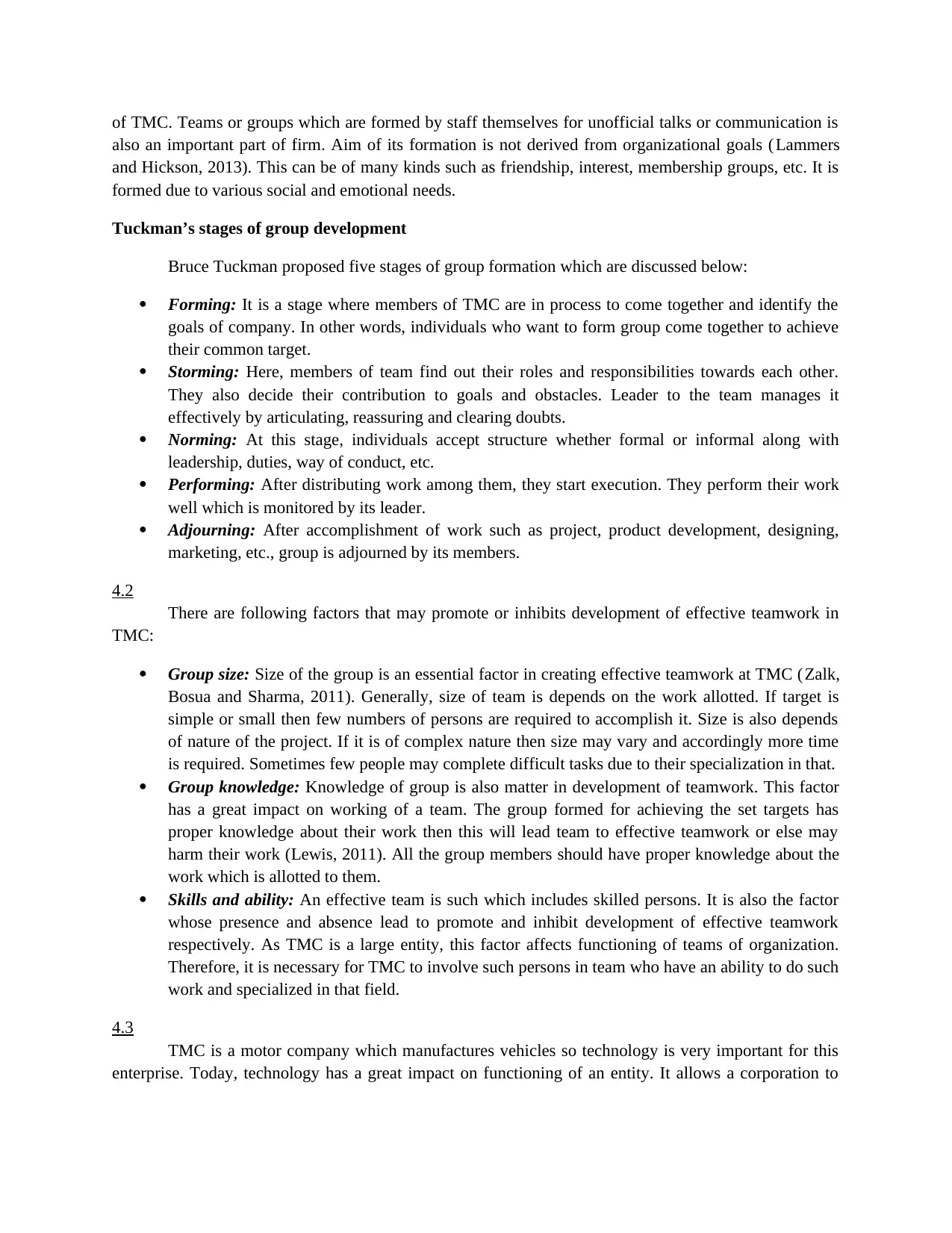
of TMC. Teams or groups which are formed by staff themselves for unofficial talks or communication is
also an important part of firm. Aim of its formation is not derived from organizational goals (Lammers
and Hickson, 2013). This can be of many kinds such as friendship, interest, membership groups, etc. It is
formed due to various social and emotional needs.
Tuckman’s stages of group development
Bruce Tuckman proposed five stages of group formation which are discussed below:
Forming: It is a stage where members of TMC are in process to come together and identify the
goals of company. In other words, individuals who want to form group come together to achieve
their common target.
Storming: Here, members of team find out their roles and responsibilities towards each other.
They also decide their contribution to goals and obstacles. Leader to the team manages it
effectively by articulating, reassuring and clearing doubts.
Norming: At this stage, individuals accept structure whether formal or informal along with
leadership, duties, way of conduct, etc.
Performing: After distributing work among them, they start execution. They perform their work
well which is monitored by its leader.
Adjourning: After accomplishment of work such as project, product development, designing,
marketing, etc., group is adjourned by its members.
4.2
There are following factors that may promote or inhibits development of effective teamwork in
TMC:
Group size: Size of the group is an essential factor in creating effective teamwork at TMC (Zalk,
Bosua and Sharma, 2011). Generally, size of team is depends on the work allotted. If target is
simple or small then few numbers of persons are required to accomplish it. Size is also depends
of nature of the project. If it is of complex nature then size may vary and accordingly more time
is required. Sometimes few people may complete difficult tasks due to their specialization in that.
Group knowledge: Knowledge of group is also matter in development of teamwork. This factor
has a great impact on working of a team. The group formed for achieving the set targets has
proper knowledge about their work then this will lead team to effective teamwork or else may
harm their work (Lewis, 2011). All the group members should have proper knowledge about the
work which is allotted to them.
Skills and ability: An effective team is such which includes skilled persons. It is also the factor
whose presence and absence lead to promote and inhibit development of effective teamwork
respectively. As TMC is a large entity, this factor affects functioning of teams of organization.
Therefore, it is necessary for TMC to involve such persons in team who have an ability to do such
work and specialized in that field.
4.3
TMC is a motor company which manufactures vehicles so technology is very important for this
enterprise. Today, technology has a great impact on functioning of an entity. It allows a corporation to
also an important part of firm. Aim of its formation is not derived from organizational goals (Lammers
and Hickson, 2013). This can be of many kinds such as friendship, interest, membership groups, etc. It is
formed due to various social and emotional needs.
Tuckman’s stages of group development
Bruce Tuckman proposed five stages of group formation which are discussed below:
Forming: It is a stage where members of TMC are in process to come together and identify the
goals of company. In other words, individuals who want to form group come together to achieve
their common target.
Storming: Here, members of team find out their roles and responsibilities towards each other.
They also decide their contribution to goals and obstacles. Leader to the team manages it
effectively by articulating, reassuring and clearing doubts.
Norming: At this stage, individuals accept structure whether formal or informal along with
leadership, duties, way of conduct, etc.
Performing: After distributing work among them, they start execution. They perform their work
well which is monitored by its leader.
Adjourning: After accomplishment of work such as project, product development, designing,
marketing, etc., group is adjourned by its members.
4.2
There are following factors that may promote or inhibits development of effective teamwork in
TMC:
Group size: Size of the group is an essential factor in creating effective teamwork at TMC (Zalk,
Bosua and Sharma, 2011). Generally, size of team is depends on the work allotted. If target is
simple or small then few numbers of persons are required to accomplish it. Size is also depends
of nature of the project. If it is of complex nature then size may vary and accordingly more time
is required. Sometimes few people may complete difficult tasks due to their specialization in that.
Group knowledge: Knowledge of group is also matter in development of teamwork. This factor
has a great impact on working of a team. The group formed for achieving the set targets has
proper knowledge about their work then this will lead team to effective teamwork or else may
harm their work (Lewis, 2011). All the group members should have proper knowledge about the
work which is allotted to them.
Skills and ability: An effective team is such which includes skilled persons. It is also the factor
whose presence and absence lead to promote and inhibit development of effective teamwork
respectively. As TMC is a large entity, this factor affects functioning of teams of organization.
Therefore, it is necessary for TMC to involve such persons in team who have an ability to do such
work and specialized in that field.
4.3
TMC is a motor company which manufactures vehicles so technology is very important for this
enterprise. Today, technology has a great impact on functioning of an entity. It allows a corporation to
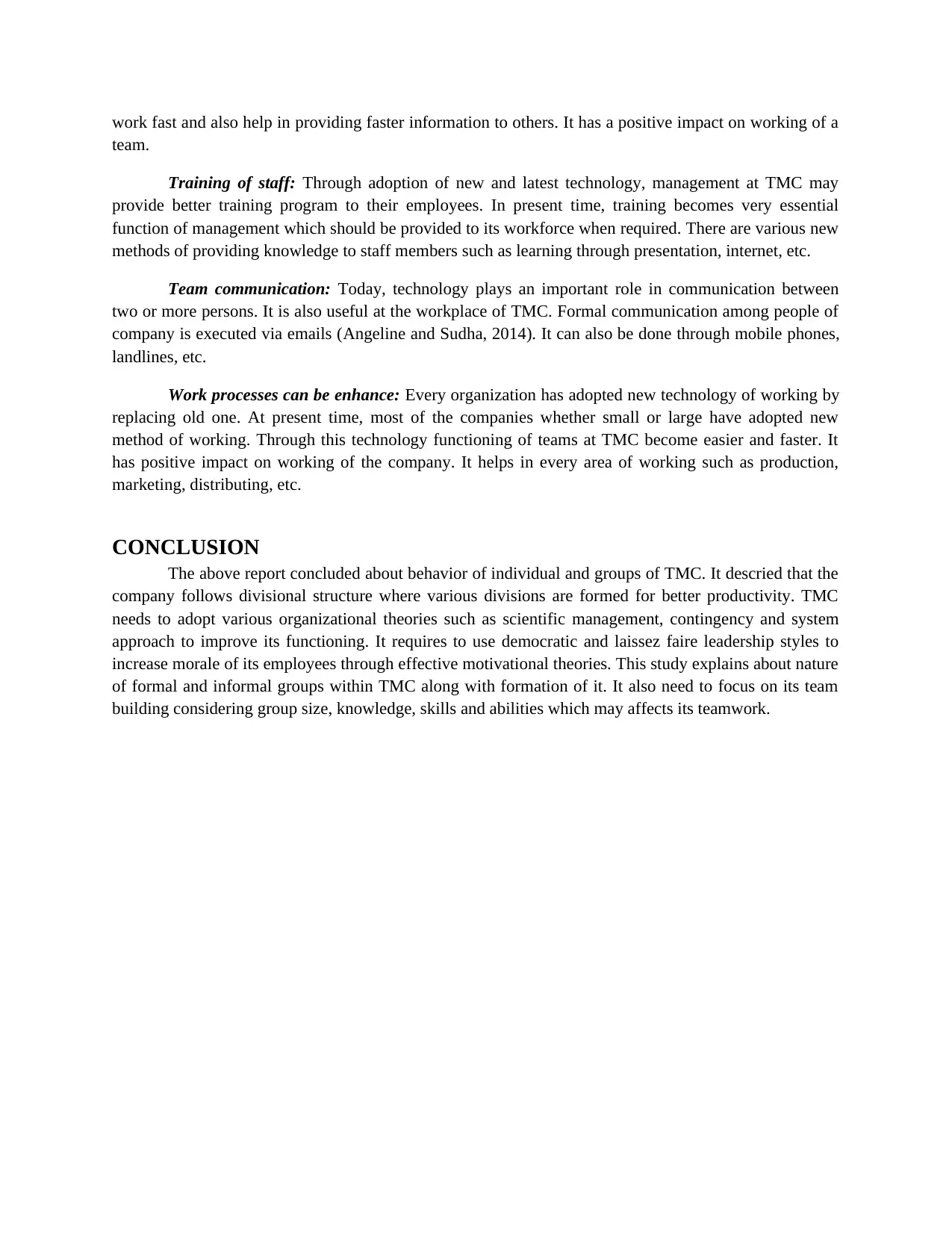
work fast and also help in providing faster information to others. It has a positive impact on working of a
team.
Training of staff: Through adoption of new and latest technology, management at TMC may
provide better training program to their employees. In present time, training becomes very essential
function of management which should be provided to its workforce when required. There are various new
methods of providing knowledge to staff members such as learning through presentation, internet, etc.
Team communication: Today, technology plays an important role in communication between
two or more persons. It is also useful at the workplace of TMC. Formal communication among people of
company is executed via emails (Angeline and Sudha, 2014). It can also be done through mobile phones,
landlines, etc.
Work processes can be enhance: Every organization has adopted new technology of working by
replacing old one. At present time, most of the companies whether small or large have adopted new
method of working. Through this technology functioning of teams at TMC become easier and faster. It
has positive impact on working of the company. It helps in every area of working such as production,
marketing, distributing, etc.
CONCLUSION
The above report concluded about behavior of individual and groups of TMC. It descried that the
company follows divisional structure where various divisions are formed for better productivity. TMC
needs to adopt various organizational theories such as scientific management, contingency and system
approach to improve its functioning. It requires to use democratic and laissez faire leadership styles to
increase morale of its employees through effective motivational theories. This study explains about nature
of formal and informal groups within TMC along with formation of it. It also need to focus on its team
building considering group size, knowledge, skills and abilities which may affects its teamwork.
team.
Training of staff: Through adoption of new and latest technology, management at TMC may
provide better training program to their employees. In present time, training becomes very essential
function of management which should be provided to its workforce when required. There are various new
methods of providing knowledge to staff members such as learning through presentation, internet, etc.
Team communication: Today, technology plays an important role in communication between
two or more persons. It is also useful at the workplace of TMC. Formal communication among people of
company is executed via emails (Angeline and Sudha, 2014). It can also be done through mobile phones,
landlines, etc.
Work processes can be enhance: Every organization has adopted new technology of working by
replacing old one. At present time, most of the companies whether small or large have adopted new
method of working. Through this technology functioning of teams at TMC become easier and faster. It
has positive impact on working of the company. It helps in every area of working such as production,
marketing, distributing, etc.
CONCLUSION
The above report concluded about behavior of individual and groups of TMC. It descried that the
company follows divisional structure where various divisions are formed for better productivity. TMC
needs to adopt various organizational theories such as scientific management, contingency and system
approach to improve its functioning. It requires to use democratic and laissez faire leadership styles to
increase morale of its employees through effective motivational theories. This study explains about nature
of formal and informal groups within TMC along with formation of it. It also need to focus on its team
building considering group size, knowledge, skills and abilities which may affects its teamwork.
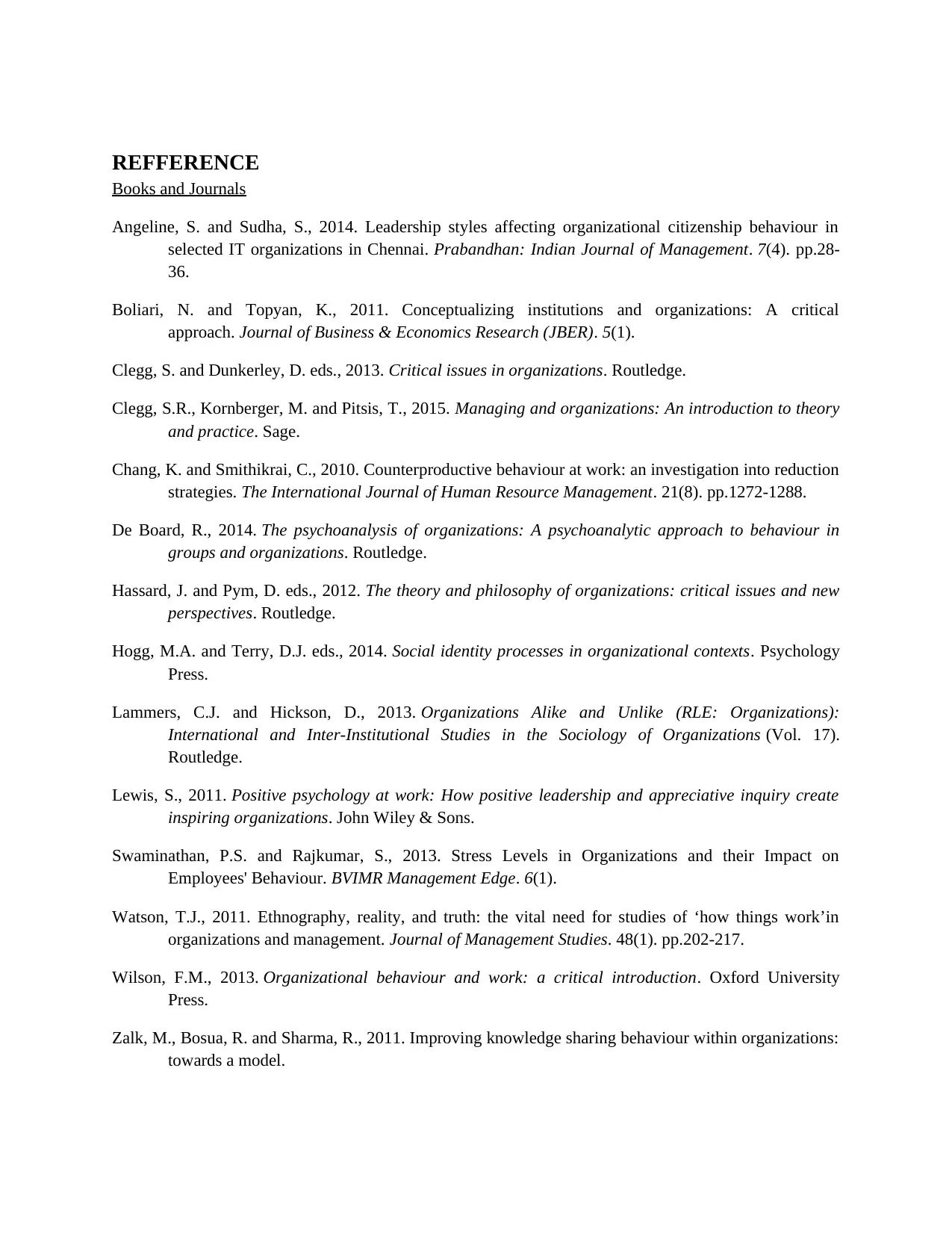
REFFERENCE
Books and Journals
Angeline, S. and Sudha, S., 2014. Leadership styles affecting organizational citizenship behaviour in
selected IT organizations in Chennai. Prabandhan: Indian Journal of Management. 7(4). pp.28-
36.
Boliari, N. and Topyan, K., 2011. Conceptualizing institutions and organizations: A critical
approach. Journal of Business & Economics Research (JBER). 5(1).
Clegg, S. and Dunkerley, D. eds., 2013. Critical issues in organizations. Routledge.
Clegg, S.R., Kornberger, M. and Pitsis, T., 2015. Managing and organizations: An introduction to theory
and practice. Sage.
Chang, K. and Smithikrai, C., 2010. Counterproductive behaviour at work: an investigation into reduction
strategies. The International Journal of Human Resource Management. 21(8). pp.1272-1288.
De Board, R., 2014. The psychoanalysis of organizations: A psychoanalytic approach to behaviour in
groups and organizations. Routledge.
Hassard, J. and Pym, D. eds., 2012. The theory and philosophy of organizations: critical issues and new
perspectives. Routledge.
Hogg, M.A. and Terry, D.J. eds., 2014. Social identity processes in organizational contexts. Psychology
Press.
Lammers, C.J. and Hickson, D., 2013. Organizations Alike and Unlike (RLE: Organizations):
International and Inter-Institutional Studies in the Sociology of Organizations (Vol. 17).
Routledge.
Lewis, S., 2011. Positive psychology at work: How positive leadership and appreciative inquiry create
inspiring organizations. John Wiley & Sons.
Swaminathan, P.S. and Rajkumar, S., 2013. Stress Levels in Organizations and their Impact on
Employees' Behaviour. BVIMR Management Edge. 6(1).
Watson, T.J., 2011. Ethnography, reality, and truth: the vital need for studies of ‘how things work’in
organizations and management. Journal of Management Studies. 48(1). pp.202-217.
Wilson, F.M., 2013. Organizational behaviour and work: a critical introduction. Oxford University
Press.
Zalk, M., Bosua, R. and Sharma, R., 2011. Improving knowledge sharing behaviour within organizations:
towards a model.
Books and Journals
Angeline, S. and Sudha, S., 2014. Leadership styles affecting organizational citizenship behaviour in
selected IT organizations in Chennai. Prabandhan: Indian Journal of Management. 7(4). pp.28-
36.
Boliari, N. and Topyan, K., 2011. Conceptualizing institutions and organizations: A critical
approach. Journal of Business & Economics Research (JBER). 5(1).
Clegg, S. and Dunkerley, D. eds., 2013. Critical issues in organizations. Routledge.
Clegg, S.R., Kornberger, M. and Pitsis, T., 2015. Managing and organizations: An introduction to theory
and practice. Sage.
Chang, K. and Smithikrai, C., 2010. Counterproductive behaviour at work: an investigation into reduction
strategies. The International Journal of Human Resource Management. 21(8). pp.1272-1288.
De Board, R., 2014. The psychoanalysis of organizations: A psychoanalytic approach to behaviour in
groups and organizations. Routledge.
Hassard, J. and Pym, D. eds., 2012. The theory and philosophy of organizations: critical issues and new
perspectives. Routledge.
Hogg, M.A. and Terry, D.J. eds., 2014. Social identity processes in organizational contexts. Psychology
Press.
Lammers, C.J. and Hickson, D., 2013. Organizations Alike and Unlike (RLE: Organizations):
International and Inter-Institutional Studies in the Sociology of Organizations (Vol. 17).
Routledge.
Lewis, S., 2011. Positive psychology at work: How positive leadership and appreciative inquiry create
inspiring organizations. John Wiley & Sons.
Swaminathan, P.S. and Rajkumar, S., 2013. Stress Levels in Organizations and their Impact on
Employees' Behaviour. BVIMR Management Edge. 6(1).
Watson, T.J., 2011. Ethnography, reality, and truth: the vital need for studies of ‘how things work’in
organizations and management. Journal of Management Studies. 48(1). pp.202-217.
Wilson, F.M., 2013. Organizational behaviour and work: a critical introduction. Oxford University
Press.
Zalk, M., Bosua, R. and Sharma, R., 2011. Improving knowledge sharing behaviour within organizations:
towards a model.
Secure Best Marks with AI Grader
Need help grading? Try our AI Grader for instant feedback on your assignments.

1 out of 11
Related Documents
Your All-in-One AI-Powered Toolkit for Academic Success.
+13062052269
info@desklib.com
Available 24*7 on WhatsApp / Email
![[object Object]](/_next/static/media/star-bottom.7253800d.svg)
Unlock your academic potential
© 2024 | Zucol Services PVT LTD | All rights reserved.





